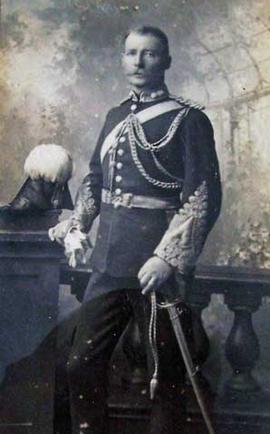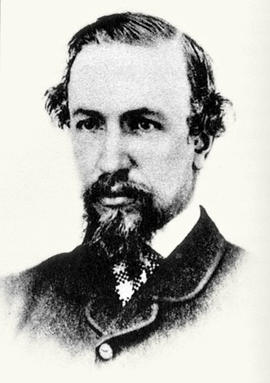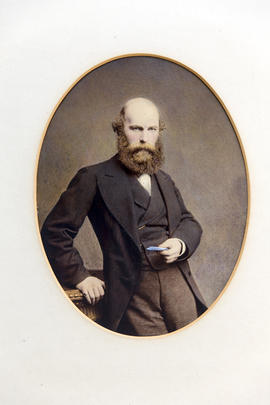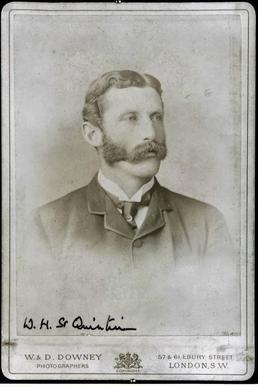Colonel William Vincent Legge was an Australian soldier and an ornithologist who documented the birds of Sri Lanka. Legge's hawk-eagle is named after him as is Legge's flowerpecked and Legges Tor, the second highest peak in Tasmania. He was a member of the Zoological Society of London
George Dawson Rowley was an English amateur ornithologist who published a series called Ornithological Miscellany in which he reprinted notes on bird studies of the time
Osbert Salvin was an English naturalist, ornithologist and herpetologist, best known for co-authoring Biologia Centrali-Americana (1879-1915) with Frederick DuCane Godman. In 1871 Salvin became editor of The Ibis. He was appointed to the Strickland Curatorship in the University of Cambridge, and produced his Catalogue of the Strickland Collection. He was one of the original members of the British Ornithologists' Union. He produced the volumes on the Trochilidae and Procellariidae in the Catalogue of Birds in the British Museum. One of his last works was the completion of Lord Lilford's Coloured Figures of British Birds (1897). Salvin was a Fellow of the Royal Society, the Linnean, Entomogical and Zoological Society of London. At the time of his death he was Secretary of the British Ornithologists' Union.
George Ernest Shelley was an English geologist and ornithologist. He was the nephew of the poet Percy Bysshe Shelley. His books included A Monograph of the Cinnyridae, or Family of Sun Birds (1878), A Handbook to the Birds of Egypt (1872) and The Birds of Africa (5 volumes, 1896-1912)
Colonel Arthur Hay, 9th Marquess of Tweeddale, known before 1862 as Lord Arthur Hay and between 1862 and 1876 as Viscount Walden, was a Scottish solider and ornithologist. He was President of the Zoological Society of London from 1868 . He had a private collection of birds, insects, reptiles and mammals, and employed Carl Bock to travel to Maritime Southeast Asia and collect specimens. Tweeddale described about 40 species collected by Bock for the first time and was elected a Fellow of the Royal Society in 1871.
William Herbert St Quintin was a British naturalist. He was a keen ornithologist, keeping a private collection of birds including Great bustards, a secretary bird and a tui. He was a founding member of the Avicultural Society in 1895, president of the Yorkshire Naturalists' Union in 1909, a member of the British Ornithologists' Union from 1883 to 1922 and also served on the council of the Royal Society for the Protection of Birds from 1908-1919
Jean Théodore Delacour was an American ornithologist and aviculturalist of French origin. He was renowned for not only discovering but also rearing some of the rarest birds in the world. He established very successful aviaries twice in his life, stocked with birds from around the world, including those that he obtained on expeditions to Southeast Asia, Africa and South America. His first aviary in Villers-Bretonneux was destroyed in the First World War, and the second one that he established at Clères was destroyed in the Second World War. He moved to the United States of America where he worked on avian systematics and was one of the founders of the International Committee for Bird Protection (later BirdLife International). One of the birds he discovered was the imperial pheasant, later identified as a hybrid between the Vietnamese pheasant and the silver pheasant
Guy Mountfort was an English advertising executive, amateur ornithologist and conservationist. He is known for writing A Field Guide to the Birds of Britain and Europe, published in 1954. In 1961 he created the World Wide Fund for Nature (then the World Wildlife Fund) with Victor Stolan, Sir Julian Huxley, Sir Peter Scott and Max Nicholson. In 1956 he led an expedition to the Coto Donana with the resulting Book Portrait of a Wilderness illustrated by Eric Hosking. In 1963 he led a party of naturalists which made the first ornithological expedition to Azraq in Jordan. The expedition's recommendations led to the creation of the Azraq Wetland Reserve and other protected areas. He was appointed an OBE in 1970, for services to ornithology. In 1972 he led the campaign to save the Bengal Tiger, persuading Indira Ghandi to create nine tiger reserves in India, with eight others in Nepal and Bangladesh
Geoffrey Francis Archer was an English ornithologist, big game hunter and colonial official. He was Commissioner and then Governor of British Somaliland between 1913 and 1922
Frank Finn was an English ornithologist. He went on a collecting expedition to East Africa in 1892, and became First Assistant Superintendent of the Indian Museum, Calcutta in 1894, and Deputy Superintendent from 1895 to 1903. He then returned to England, and was editor of the Avicultural Magazine 1909-10.




